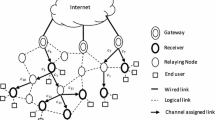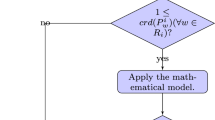Abstract
Multicast communication is an important service in wireless mesh networks (WMNs). It covers a broad range of applications, including data distribution, video conferencing, and distance learning. In this paper, we discuss the issue of bandwidth guaranteed multicast routing in multi-channel multi-radio WMNs. The problem of our concern is to construct a tree per multicast session such that the cost of the system, which is defined as the amount of total consumed bandwidth, is minimized. In order to solve the problem efficiently, we design Bandwidth Guaranteed Minimum Cost Tree construction (BGMCT) algorithm. Our algorithm yields cost-effective solutions as it exploits the wireless broadcast advantage (WBA) property of the wireless medium. In the proposed algorithm, we have developed two strategies for constructing minimum cost trees. Firstly, the number of the relay nodes in each tree is minimized. Secondly, the amount of overlapping between the shortest paths which connect different destinations of each session to its source node, is taken into account. The simulation results demonstrate that our algorithm outperforms existing solutions. Moreover, BGMCT provides near to optimal outcomes in a reasonable time.


















Similar content being viewed by others
References
Akyildiz, I. F., Wang, X., & Wang, W. (2005). Wireless mesh networks: A survey. Computer Networks, 47(4), 445–487.
Si, W., Selvadurai, S., & Zomaya, A. Y. (2010). An overview of channel assignment methods for multi-radio multi-channel wireless mesh networks. Journal of Parallel and Distributed Computing, 70(5), 505–524.
Crichigno, J., Wu, M., & Shu, W. (2008). Protocols and architectures for channel assignment in wireless mesh networks. Ad Hoc Networks, 6(7), 1051–1077.
Subramanian, A. P., Gupta, H., Das, S. R., & Cao, J. (2008). Minimum interference channel assignment in multiradio wireless mesh networks. IEEE Transactions on Mobile Computing, 7(12), 1459–1473.
Cheng, H., Xiong, N., Vasilakos, A. V., Yang, L. T., Chen, G., & Zhuang, X. (2012). Nodes organization for channel assignment with topology preservation in multi-radio wireless mesh networks. Ad Hoc Networks, 10(5), 760–773.
Franklin, A. A., Balachandran, A., & Siva Ram Murthy, C. (2012). Online reconfiguration of channel assignment in multi-channel multi-radio wireless mesh networks. Computer Communications, 35(16), 2004–2013.
Galvez, J. J., & Ruiz, P. M. (2013). Efficient rate allocation, routing and channel assignment in wireless mesh networks supporting dynamic traffic flows. Ad Hoc Networks, 11(6), 1765–1781.
Yoon, W., Lee, D., Shin, B., & Han, S. Y. (2013). Price-based congestion control and local channel-link assignment for multi-radio wireless mesh networks. Computer and Electrical Engineering. doi:10.1016/j.compeleceng.2013.11.002.
Chakchouk, N., & Hamdaoui, B. (2011). Traffic and interference aware scheduling for multiradio multichannel wireless mesh networks. IEEE Transactions of Vehicular Technology, 60(2), 555–565.
Liu, T., & Liao, W. (2008). On routing in multichannel wireless mesh networks: Challenges and solutions. IEEE Network, 22(1), 13–18.
Zeng, G., Wang, B., Ding, Y., Xiao, L., & Mutka, M. W. (2010). Efficient multicast algorithms for multi-channel wireless mesh networks. IEEE Transactions of Parallel and Distributed Systems, 21(1), 86–99.
Ding, Y., Huang, Y., Zeng, G., & Xiao, L. (2012). Using partially overlapping channels to improve throughput in wireless mesh networks. IEEE Transactions on Mobile Computing, 11(11), 1720–1733.
Li, F., Fang, Y., Hu, F., & Liu, X. (2011). Load-aware multicast routing in multi-radio multi-channel wireless mesh networks. Computer Networks, 55(9), 2150–2167.
Nguyen, H. L., & Nguyen U. T. (2011). Algorithms for bandwidth efficient multicast routing in multi-channel multi-radio wireless mesh networks. In Proceedings of IEEE wireless communications and networking conference (WCNC), pp. 1107–1112.
Chiu, H. S., & Yeung, K. L. (2010). Maximizing multicast call acceptance rate in multi-channel multi-interface wireless mesh networks. IEEE Transactions on Wireless Communications, 9(8), 2622–2631.
Avokh, A., & Mirjalily, G. (2013). Load-balanced multicast tree routing in multi-channel multi-radio wireless mesh networks using a new cost function. Wireless Personal Communications, 69(1), 75–106.
Liu, T., & Liao, W. (2010). Multicast routing in multi-radio multi-channel wireless mesh networks. IEEE Transactions on Wireless Communications, 9(10), 3031–3039.
Lim, S., Ko, Y., Kim, C., & Vaidya, N. (2011). Design and implementation of multicasting in multi-channel multi-interface wireless mesh networks. Wireless Networks, 17(4), 955–992.
Cheng, H., & Yang, S. (2011). Joint QoS multicast routing and channel assignment in multi-radio multi-channel wireless mesh networks using intelligent computational methods. Applied Soft Computing, 11(2), 1953–1964.
Nguyen, H. L., & Nguyen, U. T. (2009). Channel assignment for multicast in multi-channel multi-radio wireless mesh networks. Wireless Communication and Mobile Computing, 9(4), 557–571.
Kumar, N., Chilamkurti, N., & Lee, J. H. (2013). UBMR-CA: Utility-based multicast routing and channel assignment with varying traffic demands in multi-radio multi-channel wireless mesh networks. Mathematical and Computer Modelling, 57(11–12), 2750–2763.
Zeng, G., Wang, B., Mutka, M., Xiao, L., & Torng, E. (2012). Efficient link-heterogeneous multicast for wireless mesh networks. Wireless Networks, 18(6), 605–620.
Oh, K. J., & Lee, C. Y. (2010). Multicast routing protocol with low transmission delay in multi-rate, multi-radio wireless mesh networks. In Proceedings of IEEE international conference on communications (ICC), pp. 1–6.
Qadir, J., Chou, C. T., Misra, A., & Lim, J. G. (2009). Minimum latency broadcasting in multiradio, multichannel, multirate wireless meshes. IEEE Transactions on Mobile Computing, 8(11), 1510–1523.
Avokh, A., & Mirjalily, G. (2013). Interference-aware multicast and broadcast routing in wireless mesh networks using both rate and channel diversity. Computers & Electrical Engineering. doi:10.1016/j.compeleceng.2013.05.008.
Wang, Z., & Crowcroft, J. (1996). Quality of service for supporting multimedia applications. IEEE Journal of Selected Areas in Communication, 14(7), 1228–1234.
Ruiz, P. M., & Gomez-Skarmeta, A. F. (2005). Approximating optimal multicast trees in wireless multi-hop networks. In Proceedings of IEEE symposium on computers and communications (ISCC), pp. 686–691.
Acharya, P. A. K., & Belding, E. M. (2011). MARS: link-layer rate selection for multicast transmissions in wireless mesh networks. Ad Hoc Networks, 9(1), 48–60.
Zhao, X., Chou, C. T., Guo, J., & Jha, S. (2007). A scheme for probabilistically reliable multicast routing in wireless mesh networks. In Proceedings of IEEE conference on local computer networks (LCN), pp. 213–214.
Zhao, L., Al-Dubai, A. Y., & Min, G. (2010). GLBM: A new QoS aware multicast scheme for wireless mesh networks. Journal of Systems and Software, 83(8), 1318–1326.
Pourfakhar, E., & Rahmani, A. M. (2010). A hybrid QoS multicast framework-based protocol for wireless mesh networks. Computer Communications, 33(17), 2079–2092.
Nguyen, U. T. (2008). On multicast routing in wireless mesh networks. Computer Communications, 31(7), 1385–1399.
Dijkstra, E. W. (1995). A note on two problems in connection with graphs. Numerical Mathematics, 1(1), 269–271.
Gupta, P., & Kumar, P. R. (2000). The capacity of wireless networks. IEEE Transactions on Information Theory, 46(2), 388–404.
Garey, M. R., & Johnson, D. S. (1979). Computers and intractability: A guide to the theory of NP-completeness (Series of Books in the Mathematical Sciences) (pp. 245–248). New York: W. H. Freeman and Company.
ILOG Cplex, Optimization software for mathematical programming. http://www-01.ibm.com/software/integration/optimization/cplex-optimizer/.
Acknowledgments
This work is supported in part by Iran Telecommunications Research Center (ITRC) under grant 19259/500.
Author information
Authors and Affiliations
Corresponding author
Appendices
Appendix 1
Lemma 1
Constraint (9) guarantees that \(T_m \left( {1\le m\le M} \right) \) is loop-free.
Proof
Assume there is a loop in \(T_{m}\), and nodes \(v_i \left( {1\le i\le q} \right) \) are in the loop. In this loop, \(p_{v_{i+1} }^m =v_i \left( {1\le i<q} \right) \) and \(p_{_{v_1 } }^m =v_q \). According to (9), \(\varepsilon +h_{v_i }^m \le h_{v_{i+1} }^m \left( {1\le i<q} \right) \) and \(\varepsilon +h_{v_q }^m \le h_{v_1 }^m \). Using these inequalities, it can be derived that \(\varepsilon \le 0\), which is in contradiction to the initial assumption. \(\square \)
Lemma 2
In \(T_m \left( {1\le m\le M} \right) \), the source node \(s_{m}\) is connected to all destinations in \(D_{m}\).
Proof
the existence of the path is shown in a bottom-up manner. According to (4), each destination \(v\in D_m \) has a parent node. In addition, according to (8), \(p_v^m \) must have a parent. Continuing this procedure, a chain of nodes is formed. The length of this chain is bounded by \(\left| V \right| \). Since \(\left| V \right| \) is finite, the chain has a tail. According to Lemma 1, \(T_{m}\) is loop-free. Hence, the tail of the chain is a node that has no parent. The only node that preserves this constraint is \(s_{m}\). \(\square \)
Appendix 2
Linearizing (11): To avoid the quadratic term on the right hand side of (11), it is replaced by the following constraints:
Linearizing (12): We formularize \(\mathop {\min }\nolimits _{w\in \textit{RNH}_u^{\textit{mk}} } \left\{ {c_{uw} } \right\} \) at the first step. To do this, nodes of \(N_{u}\) are sorted in ascending order according to the capacity of their common links with node \(u\). If node \(w_{i}\) is a receiver node of \(\textit{NH}_u^{\textit{mk}} \), and its preceding nodes are not in the NH, \(\mathop {\min }\nolimits _{w\in \textit{RNH}_u^{\textit{mk}} } \left\{ {c_{uw} } \right\} \) will be equal to \(c_{uw_i } \). This condition is formally stated as:
By combining (12) and (29), some binary products in the form of \(nl_{uv}^{\textit{mk}} \prod \nolimits _{w_l \in p(N_v,j)} {nl_{uw_l }^{\textit{mk}} } \) \(\left( {1<j\le \left| {N_u } \right| } \right) \) are appeared, where \(p\left( {N_v, j} \right) \) presents the permutation of \(j\) neighbors from the nodes of \(N_{v}\). The term is linearized by replacing it with auxiliary variable \(axh_{uvp}^{\textit{mk}} \) and including the following constraints in the model:
Doing so, the product term \(t_u^{\textit{mk}} axh_{uvp}^{\textit{mk}} \) is appeared in (12), which is replaced by auxiliary variable \(axht_{uvp}^{\textit{mk}} \). The mentioned variable is linearized as follows:
Linearizing \(nl_{uv}^{\textit{mk}} t_u^{mk} \) : This quadratic term is appeared in (13), (16) and (17). To linearize the term, it is replaced by an auxiliary variable \(axlt_{uv}^{\textit{mk}} \) and the following constraints are added to the model:
Linearizing \(aux_v^k \) -variable: The \(aux_v^k \) variable that appeared in (14), is equal to 1 if one of the \(nl_{uv}^{\textit{mk}} \)-variables \(\left( {\forall \left( {u,v} \right) \in E, 1\le m\le M} \right) \) is set to 1. Therefore, it can be expressed linearly as follows:
Rights and permissions
About this article
Cite this article
Farzinvash, L., Dehghan, M. Minimum Cost Bandwidth Guaranteed Multicast Routing in Multi-channel Multi-radio Wireless Mesh Networks. Wireless Pers Commun 80, 493–520 (2015). https://doi.org/10.1007/s11277-014-2023-5
Published:
Issue Date:
DOI: https://doi.org/10.1007/s11277-014-2023-5




